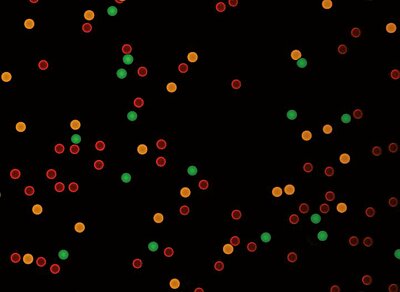Applications of Fluorescent Beads
PolyAn's functionalized fluorescent micro- and nanobeads can be used in a wide range of applications including multiplexed bead assays, for calibration of flow cytometers and fluorescence imaging systems, and as versatile platform for bead-based bioassays in LifeScience research.
Flow Cytometry
PolyAn’s beads can be used as valuable tools for achieving accurate and consistent results within a flow cytometry study, and generating comparable data between instruments and laboratories. The bead populations are valuable tools for assay development.
PolyAn’s PMMA beads with narrow fluorescence coefficients of variation (CVs) are used for Q&B (alignment, non-fluorescent and dimed population in addition to the bead fluorescence population of choice for background and sensitivity). They can also be used as compensation controls including antibody binding and help estimate the cell size.
- Spectrum Calibration Beads with up to 8 fluorescence intensities
- Fluorescent PMMA Microparticles
- Functionalized, fluorescent PMMA Microparticles
- Functionalized, fluorescent PMMA Nanoparticles
Multiplex Bead Assays for Flow Cytometry
Bead-based multiplexed assays using flow cytometry (also called Bead Suspension Arrays) are commonly used both in in-vitro diagnostics and LifeScience screening applications. PolyAn’s multiplex beads for flow cytometers feature up to 30 populations of microbeads coated with different ligands to interrogate multiple targets within a single sample.
By combining the PolyAn Red4 and PolyAn Blue Plex beads it is possible to further increase the number of populations to 38.
(in vivo) Imaging
PolyAn’s bio-compatible PMMA bead suspensions can be used in conjunction with living cells to help process cell assays more quickly by indication of the correct focus level in fluorescence microscopy. They can also be used for calibration in 3D-printing or single cell spotting.
Fluorescence Lifetime Imaging
Differences in fluorescence-lifetime are for example used in fluorescence lifetime imaging microscopy (FLIM). FLIM is an imaging technique for producing an image based on the differences in the exponential decay rate of the fluorescence from a fluorescent sample. PolyAn offers beads which are encoded with different fluorescent lifetimes.
Multiplex Bead Assays for Fluorescence Imaging
Addressable bead populations with different intensities of fluorescence and/or size can be used for the development of multiplexed bead assays. PolyAn’s multiplex beads optimized for use with fluorescence microscope based imaging systems (Scanning Cytometry, SCM).
Fluorescence Standards for Calibration
PolyAn offers calibration slides for microscope based imaging systems that are used to standardize measurements of fluorescence intensity based on immobilized fluorescent calibration beads.
Latex Agglutination Tests
In the classic latex agglutination tests, beads are coated with antigen for detection of antibody in serum or blood samples. If present, the antibody bridges the antigen-coated microparticles, causing agglutination or aggregation. Positive results are visually apparent as the homogeneous, milky white suspension takes on a grainy or sandy appearance.
Fluid tracing and cell tracking
Fluorescent microspheres are useful for fluid tracing, cell tracking, or phagocytosis studies. PolyAn offers a broad portfolio of beads at different sizes and a wide selection of fluorophores.
Catalysis, Enzyme Immobilisation and Scavenger Materials
Chemically and mechanically robust Polyethylene microparticles that are functionalised with a reactive surface matrix to efficiently immobilise catalysts, enzymes and other molecules.

